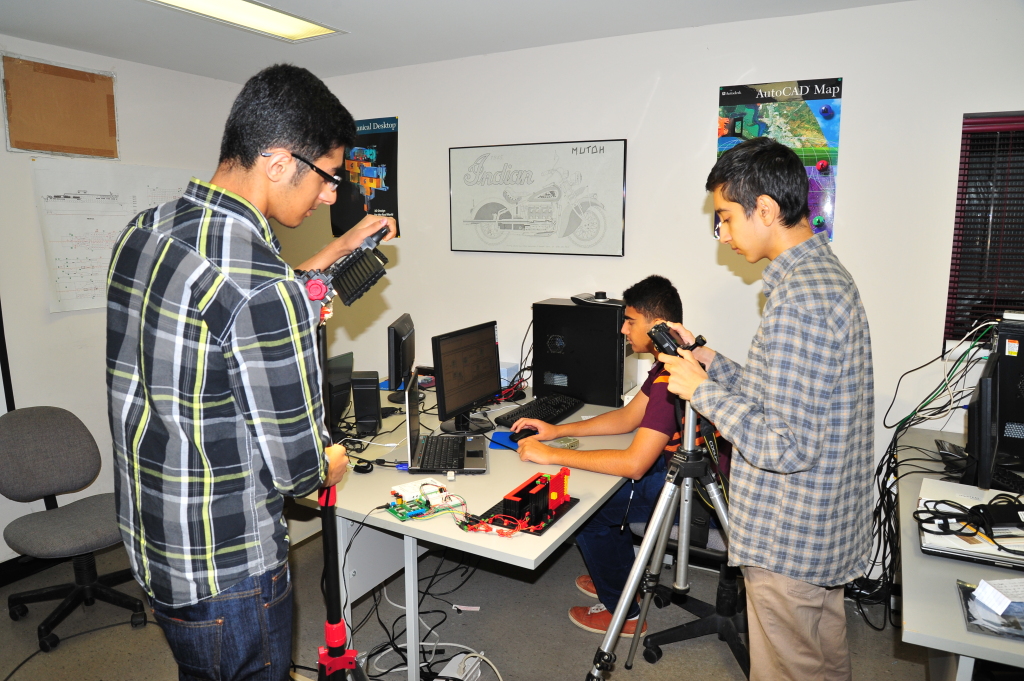This past July, Studica has had the pleasure of hosting three students for the summer
co-op session here at our Mississauga, Ontario location. Studica is dedicated to providing students and educators with the very best in STEM resources, and was thrilled to give students hands-on experiences with STEM skills. This placement in co-operation with the Peel District School Board helps meet the increasing demand for STEM curriculum in schools, and prepares students for future workplace environments. Our three co-op students, Moulik, Justin and Arsalaan, developed key skills to achieve academic and career success.
Studica asked the students to design a small project using various engineering and design components. They were charged with designing and constructing this project within pre-determined guidelines using the following items: fischertechnik, mySTEM Do Engineering Kit, Studica’s mySTEM™ board, NI myDAQ, XYZ DaVinci 3D Printer and LabView Student Edition. Assembly was completed with fischertechnik parts and mySTEM Do Engineering Kit, while the mySTEM™ board and NI myDAQ were used for wiring motor and sensor components. Additional, custom components were printed using the DaVinci 3D printer, and LabVIEW assisted in the student’s programming of the final product.
Overview of STEM Education Program
Week 1: Developing Basic Programming Skills
During the first week, the students worked with LabVIEW tutorials and mySTEM project board’s intro curriculum to develop their basic programming skills in preparation for their project. They also familiarized themselves with the various parts and mechanics of the mySTEM Do Engineering Kit.
The team had a great first week with great mentors and supervisors helping every step along the way. They absolutely looked forward to finishing their project on time and showing what three motivated minds could achieve with the right mentorship and resources.
Week 2 & 3: Construction and Re-design
During the second and third weeks, the main goal was to complete construction of the components and then proceed to link them together. The students planned to start testing and troubleshooting by the end of the second week.
Initially, the team had agreed to design and build a Rube Goldberg machine. Their original design included the following systems: a marble drop, Ferris wheel, bridge and lift. The co-op students were optimistic and excited to continue working on their project and enhancing their STEM education through mechanics and programming. After brainstorming and further analysis, the Rube Goldberg machine had to be shelved as the original design exceeded the scope of the available parts and components in the Do Engineering Kit. Instead, they decided to build four models demonstrating real-life mechanisms: a ski lift, car jack, bank safe and microwave.
Built using fischertechnik parts, these models would replicate the mechanisms used in real-world products and applications. This allowed the students to explore designing and building the models using hands-on experimentation. The models were controlled by the NI myDAQ programmed with LabVIEW Student Edition along with the Studica mySTEM Project Board.
The team successfully completed two of the models in their third week, the ski lift and the car jack, and looked forward to completing the other two designs – the microwave and bank vault.
Week 4: STEM Designs Completed
The fourth and final week proved to be a very productive week for the team. The two remaining models, the bank vault and the microwave, were successfully built, programmed and tested – just in time for their school’s career fair.
The remainder of the project involved creating documentation and demonstration videos for the models by the end of the next week. These STEM models were documented to improve understanding of the mechanics and programming behind their functionality. The documentation included a picture of the model, a description of its functionality and wiring, a difficulty rating, and sample VIs.
Conclusion of Co-op Project
Initially, the students expected to develop skills that were relevant to their potential careers. However, they did not expect to be capable of completing the models due to a lack of familiarity with LabVIEW and fischertechnik.
At the end of the placement, however, the students had exceeded their expectations after completing all four models on time. They gained practical knowledge in graphical programming via LabVIEW and simple electronics from the NI myDAQ and Studica mySTEM project board, as well as personal skills including; problem solving, organization and communication skills, teamwork, and personal discipline skills, including perseverance and time management. These important skills will help these students both in an academic environment as well as in future jobs.
Studica is dedicated to supporting engaging STEM Education, which in turn allow teachers to provide students with opportunities to acquire skills for a successful future. We are proud to say that the placement was able to inspire these students to possibly pursue a STEM-based Post-secondary Education. Giving them the chance to experiment with robotics tasks such as researching, designing and programming, helped them clarify their career choices.
The co-op students found the work to be both engaging and exciting. They highly recommend this type of co-op placement for those interested in getting real work experience and trying to make a decision in regards to a career in STEM industries. Studica was very happy to host these summer co-op students, and we encourage fellow educators to reach out to STEM experts in various industries and create an interactive STEM-based curriculum for their students.
More videos of parts 2-4 can be found on the Studica YouTube Channel
Author: Edward Wang, Intern Summer 2014
Share this Post


